UniSA researchers to help NASA monitor health in space
By Michèle Nardelli and Andrew Spence
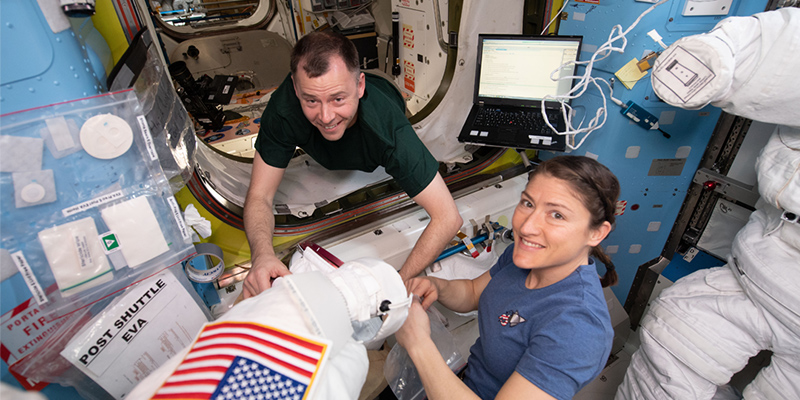 TECHNOLOGY AND ENGINEERING NASA astronauts Nick Hague and Christina Koch work on US spacesuits in the Quest airlock before embarking on a series of spacewalks on the International Space Station. The spacesuits of the future could be embedded with technology developed by UniSA researchers. Image courtesy NASA.
TECHNOLOGY AND ENGINEERING NASA astronauts Nick Hague and Christina Koch work on US spacesuits in the Quest airlock before embarking on a series of spacewalks on the International Space Station. The spacesuits of the future could be embedded with technology developed by UniSA researchers. Image courtesy NASA.UniSA is working with NASA to develop wearable sensors to provide real time information about the health of astronauts.
The Australian National Fabrication Facility (ANFF) has partnered with NASA to help Australian researchers develop sensors to monitor health through the testing of bodily fluids such as sweat and saliva. The “wearable” technology could monitor blood pressure, radiation, humidity, gases – identifying potential issues quickly and easily.
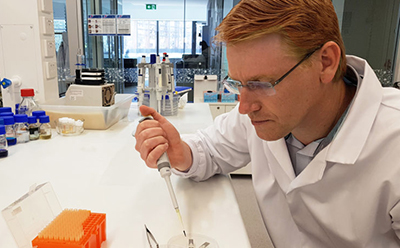 ANFF-SA Node Director Associate Professor Craig Priest will work with NASA to develop sensors to monitor human health in space.
ANFF-SA Node Director Associate Professor Craig Priest will work with NASA to develop sensors to monitor human health in space.ANFF SA Node Director and Foundation Fellow at the UniSA’s Future Industries Institute, Associate Professor Craig Priest, says the partnership was an example of “the very first fruits of return on investment” for Australia’s rebooted space industry and would harness exciting nanotechnology and microfluidics research at the UniSA Mawson Lakes campus.
“When you are working and travelling in space there is no doctor on board or regular health testing facilities and we know astronauts are operating in a challenging environment,” he says.
"You can imagine in a space environment where you’ve got zero gravity, radiation and other extreme conditions, the ability to know if things are going wrong quickly is very important.
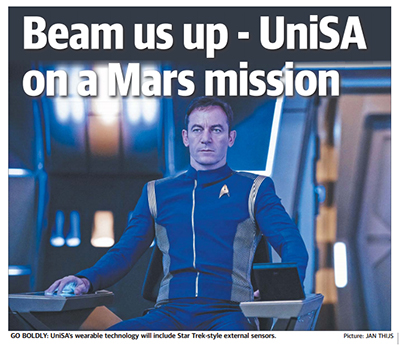 The Advertiser front page 23 October 2019
The Advertiser front page 23 October 2019“We are aiming to work with NASA to develop non-invasive health self-assessment – and possibly wearable – tools that will be able to analyse things like sweat and saliva and track health effects in real time.
“The research supports ambitions for further and longer journeys into space and will help astronauts to monitor and mitigate the physiological effects of longer exposure to space environments.”
Assoc Prof Priest leads research into the development of microfluidic sensor platforms designed to monitor human health factors, which will be an initial focus of the international partnership with NASA.
Assoc Prof Priest says the technologies developed for NASA would ultimately also be used for applications on Earth.
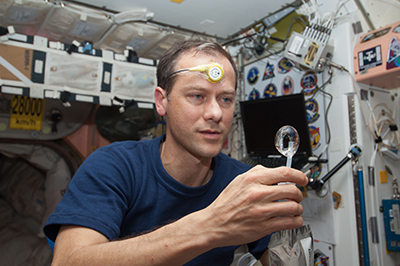 NASA astronaut Tom Marshburn, Expedition 34 flight engineer, squeezes a water bubble out of his beverage container in the Unity node of the International Space Station. He is wearing a sensor to monitor circadian rhythms due to changes of a non-24 hour light-dark cycle. In the future, such sensors could be incorporated into clothing through work by UniSA researchers. Image courtesy NASA.
NASA astronaut Tom Marshburn, Expedition 34 flight engineer, squeezes a water bubble out of his beverage container in the Unity node of the International Space Station. He is wearing a sensor to monitor circadian rhythms due to changes of a non-24 hour light-dark cycle. In the future, such sensors could be incorporated into clothing through work by UniSA researchers. Image courtesy NASA.“Increasingly health management is going to go towards looking for those early signs so we hope that some of these sensors will be able to head off health challenges quite quickly,” he says.
“Ultimately it should return to Earth and help all of us but the target of it here is to go for those challenging environments where you don’t have much water or large laboratories – you’ve got small spaces and lightweight equipment.
“What does that mean for being able to do clinical level testing in an environment where you just don’t have the clinic?
“Whatever technologies that are developed in this area of research are eventually going to find their way into our pockets or onto our wrists and it’s those types of technologies that I believe are going to be the game changers for health management and early intervention in space and on Earth.”
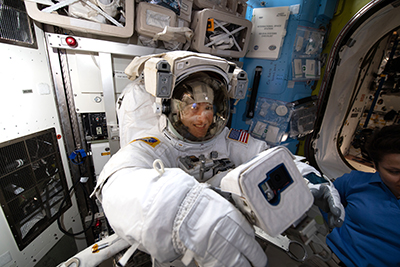 Expedition 56-57 crew member Serena Auñón-Chancellor of NASA trains inside the Space Station Airlock Test Article wearing a US spacesuit. Wearable technology being developed in a partnership between UniSA researchers and NASA could be used to monitor the blood pressure, radiation, humidity and gases of astronauts. Image courtesy NASA.
Expedition 56-57 crew member Serena Auñón-Chancellor of NASA trains inside the Space Station Airlock Test Article wearing a US spacesuit. Wearable technology being developed in a partnership between UniSA researchers and NASA could be used to monitor the blood pressure, radiation, humidity and gases of astronauts. Image courtesy NASA.The announcement is expected to be the first of many projects enabled by the agreement and coincided with the 70th International Astronautical Congress (IAC), held in Washington DC during October.
More than a dozen Australian space organisations ranging from startups to universities and established aerospace companies were part of the Australian Space Agency stand at the exhibition. These include eight entities from South Australia: Nova Systems, SmartSat CRC (led by UniSA), Neumann Space, Inovor Technologies, Silentium Defence, Southern Launch, UniSA’s Innovation and Collaboration Centre and Flinders University.
Australia’s rebooted space industry is positioning itself as a world leader in the development of smart satellites and associated technologies that will streamline communication, drive the Internet of Things, enhance Earth Observation and shape the defence forces of the future.
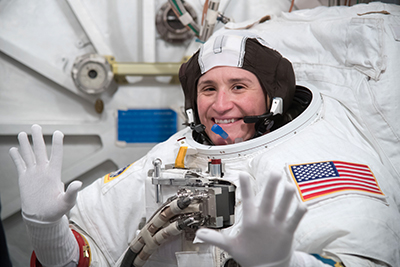 Expedition 56-57 crew member Serena Auñón-Chancellor of NASA trains inside the Space Station Airlock Test Article wearing a US spacesuit. Wearable technology being developed in a partnership between UniSA researchers and NASA could be used to monitor the blood pressure, radiation, humidity and gases of astronauts. Image courtesy NASA.
Expedition 56-57 crew member Serena Auñón-Chancellor of NASA trains inside the Space Station Airlock Test Article wearing a US spacesuit. Wearable technology being developed in a partnership between UniSA researchers and NASA could be used to monitor the blood pressure, radiation, humidity and gases of astronauts. Image courtesy NASA.The Australian Government aims to grow the space market segment from AU$3.9 billion to AU$12 billion by 2030 and double space industry employment to 30,000.
The South Australian node of the ANFF-SA was established under the National Collaborative Research Infrastructure Strategy and is funded by Commonwealth and State Governments, the CSIRO and participant universities. It complements UniSA’s Future Industries Institute’s research infrastructure at Mawson Lakes.
Director of UniSA’s Future Industries Institute Professor Emily Hilder says the partnership with NASA is a strong indicator of the quality and relevance of the research being undertaken in South Australia.
“This is a hugely exciting project and testament to the world class talent we have at UniSA,” Prof Hilder says.
“It also shows that UniSA researchers are playing an important role in some of the many applications supporting the international space industry.”
This article is partially republished from The Lead South Australia under a Creative Commons license. Read the original article.
Other Stories
- UniSA researchers to help NASA monitor health in space
- Great career prospects for UniSA graduates, new government data shows
- Parents left in the cold when it comes to kids with autism
- New multilevel homes become heat traps in summer
- From the Vice Chancellor
- Achievements and Announcements
- World first study with drone cameras able to identify survivors
- Wastewater study pinpoints cities across the world with high drug use
- UniSA ranked top in SA for Education, Law, Business and Economics
- Opportunity for almost 200 UniSA students to study in Indo-Pacific in 2020
- Intensive course empowers women impacted by domestic violence and homelessness
- The magic that happens when a nanoengineer and immunologist collaborate
- UniSA takes reins on world first Invictus Pathways Program for Aussie veterans and first responders
- New Social Enterprise Hub to foster social innovation and entrepreneurship
- New partnership with MIT to underpin data visualisation research
- UniSA Vietnamese law student wins SA’s top honour
- The latest books from UniSA researchers
- UniSA Alumni Awards and UniSA Research Day
- Australia’s drought relief package hits the political spot but misses the bigger point
- Relive the Hawke Centre’s latest events
- Read the latest edition of unisabusiness magazine
- Read the latest edition of enterprise magazine



